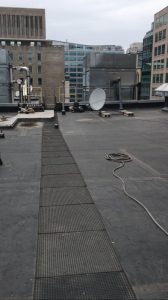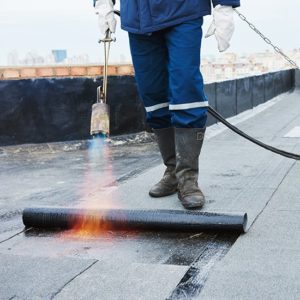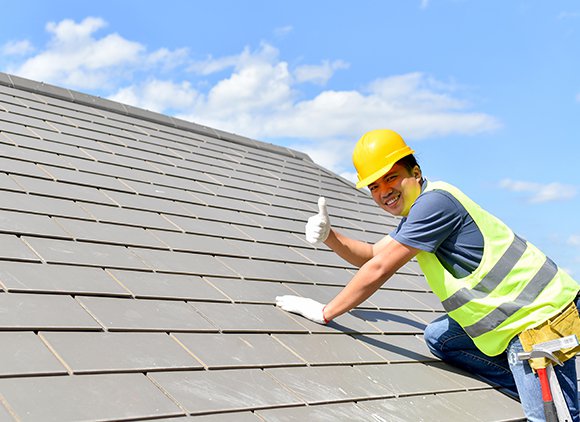
05 Oct Flat Roof Repair – How to Repair a Leaky Flat Roof
The average cost of flat roof repair is significantly cheaper than the cost of a full flat roof replacement. This is one of the reasons why excellent flat roof repair is essential.
Moreover, having a pro repair your flat roof can easily extend its lifespan by at least 3-5 years. However, in some cases, trying to fix a leaking roof membrane might be a futile effort and a complete waste of money.
Also, regular roof leaks, water damage and other issues may occur due to faulty or poor installation or old age of the roof itself. If you own a commercial building in some areas in Toronto, the odds are that it has a flat roof.
Notably, these are popular among builders and business owners due to their low cost and ease of maintenance.
However, if you fall behind in keeping up with repairs, your roof could quickly deteriorate in the event of a major storm. Sometimes, you may not know you have an issue until it’s too late for easy repair. Imagine waking up in the morning only to realize your leaky flat roof has turned the inside of your building into a swimming pool.
Several homes and buildings opt for flat roofing structures, to give a subtle aesthetic look. Although flat roofing is efficient and durable, it requires a lot of close checks and maintenance. Often flat roof repair companies offer a periodic inspection on breakdowns, maintenance, and splits. All of this will keep your home and bank account in good shape.
The versatility of flat roof designs is a plus for many people. However, even a minor crack can create significant havoc in the structure. Also, if it appears in front of your building, it may compromise the aesthetic appeal of your building. In this scenario, commercial flat roof repair from a reputable company can save you from having to deal with all of this hassle.
As an introduction, flat roofs are not flat and have a minor roof pitch inconsistent gaps. Usually, these gaps are formed from ¼” to ½” for every foot. A slight slope will give excellent drainage to the water, but if not maintained well, it can be a big problem.
In this article, we will explain how you can repair a leaky flat roof without much stress. We will show you how to repair a leaky flat roof and keep the insides of your home safe.
What is a flat roof?
 A flat roof is a roof that is almost level. This is in stark contrast to the many types of sloped roofs. The slope of a roof is properly known as its pitch, and flat roofs have up to approximately 10°. Flat roofs are a tested and trusted form of roofing mostly used in extreme climates.
A flat roof is a roof that is almost level. This is in stark contrast to the many types of sloped roofs. The slope of a roof is properly known as its pitch, and flat roofs have up to approximately 10°. Flat roofs are a tested and trusted form of roofing mostly used in extreme climates.
Flat roofs, also known as “low-slope” roofs, are commonly found on commercial buildings throughout the world. They are generally defined as a low-slope roof
Flat roofs exist all over the world, and each area has its tradition or preference for materials used. In warmer climates, where there is less rainfall and freezing is unlikely to occur, many flat roofs are built of masonry or concrete.
In this case, it’s good at keeping out the heat of the sun, cheap and easy to build where timber is not readily available. However, flat roofs are not suitable for some areas and are may not be advisable for safety reasons. Such areas include where the roof could become saturated by rain and leak, or where water soaking into the brickwork can freeze, thereby compromising the integrity of the roof.
In Canada, flat roofs are very common. They suit the climate, are aesthetic and durable when taken care of properly.
Types of flat roof
Here, the good thing is, the flat roof has various material options that are different from the traditional flat roofing system. This also enhances the reliability of the top roof.
There are different types of flat roofs. However, if we look at the various types, flat roofs can be hugely categorized as:
Single Layer Membrane
This type of roofing is made with superior shielding technology. Most of these are preferred for commercial construction needs. Professionals call it “Elastomeric”.
These roofs have certain varieties:
- Neoprene
- EPDM
- Chlorinated polyethylene and chlorosulfonated polyethylene sheets
- PVC
- Polymer-modified
Amidst all of these types, EPDM (synthetic rubber), is the most preferable. This is widely used in residential and commercial utilization. The UV radiation is dangerous for your roof. So, if nothing, you can always suggest that your contractor puts on an EPDM roof shield for your home.
Conventionally and technically, these membrane roofs are deployed in various ways. However, EPDM roof types are tied via welding or through stickiness.
Built-Up Roofing
Built-up Roofs or BUR is a type of flat roof that solves the house shielding problems. Built-up roofs are deployed with different layers. In this type of roof, bitumen is used with a smouldering hot mop. The application of hot tar mixes with bitumen and makes an appearance of a monolithic roof membrane.
The roof asphalt layer overlaps until the application builds a thickness. A top surface that is made from stone particles is applied to the top layer. This protects the roof from UV rays.
Some general repairs with these flat roofs can be attained with a little extra dedication. If you have a fear of heights, then flat roof repair professionals should be your first point of contact. 
Modified Bitumen Roof
This was the outcome of strategized replacement technology for BUR. During the era of the 1960s, this was formulated to add a polymer roof layer with the BUR sheets.
Several installation methods include:
- Torch Applied Technique
- Cold Applied Technique
- Self-Adhered Technique
- Hot-Applied Technique
Modified bitumen roofs offer enhanced elasticity, even in the low temperatures. Polymers are polypropylene, which offers features like rubber roofs.
The benefits of a flat roof
One of the most common options people choose for their buildings is a flat roof. Flat roofs hold several benefits, from safety to practicality – let’s take a look at a few.
Space
A flat roof is a great place to store items that may have no other sensible home. You can store an AC vent or other heavy equipment easily, with simple access to them if you need it. Especially for a commercial business where space might be a severe issue at times, this is an excellent tangential benefit.
Durability
It’s very easy to maintain the composition of a flat roof. Also, the gravel and tar structures that form their basis last a very long time. Most products can resist basic elemental damage for over thirty years.
Cost
Both in terms of installation and future services, flat roofs are some of the most affordable out there. Their maintenance is easy, as we noted above, which means expensive flat roof repairs aren’t often needed.
There’s also no need for shingles or any other decorative elements on the surface, which means installation costs are low. Even repairs are relatively cheap when they’re rarely required – it’s easy to repair these sorts of surfaces.
Access and Maintenance
Because there’s no slope and a flat surface, accessing a flat roof is extremely easy. It typically takes only a ladder and sometimes not even that in commercial settings.
This makes it very easy to perform basic maintenance, on the roof itself. Tasks such as rain gutters and sidings can be carried out easily. With the ability to get up there and check the problem, many more costly repairs can be avoided.

Causes of flat roof leakages
A flat roof leak may come as a shock to you. Your investment may go up in smoke if you do not take the necessary precautions into account. Therefore, if you have a roof over your head that can save you from stormy and rainy nights, then you should try as much as possible to make it free from leakages.
Leakages are a big deal with a flat roof. Your flat roof will be prompt in showing a leakage as the water gets quickly into the breakage. Before you try to repair your flat roof, you must check on the cause of roof leakage. That way, you can understand the problem before resolving it.
Some key factors which affect the flat roof leakage are:
- The severity of environmental factors such as wind, snow, rain and pressure. These factors can combine to cause cracks and breakage in the roof.
- Water collection which leads to standing water. Over time, this weakens the roof surface and makes it less durable.
- Outdated roof installation and insulation techniques can cause lesser longevity. In this condition, extreme weather conditions and temperatures can make your roof tear.
You can always fix the problem, but that will cause another maintenance charge to your budget.
If the condition is too severe, some replacement options are:
- Metal roof installation
- Built-up Roof or BUR
- Coating with Spray
- Bitumen application
How to repair a leaky flat roof in Toronto
Flat roofs work well, but you do need to inspect them constantly for cracks and other signs of damage. Most flat roofs are made of PVC, asphalt, rubber, or other synthetic material.
Rubber and synthetic membranes are often simple to fix with adhesive patches, while asphalt can be repaired with caulk or resealed with bitumen. Unless your roof is in terrible shape, diligence with repairs prevents extensive damage and gives your roof a longer lifespan.
Locating a leak for flat roof repair
While finding a leak in a flat roof is more comfortable than on a steep-sloped, shingled roof, leaks can still be deceiving. Where the water enters your interior space might not be exactly where the leak is, because any water that penetrates your roofing membrane can travel for some distance until it finds a seam in the sub-roof or sheathing and seeps inside.
These steps will allow you to isolate the source of the leak if it isn’t readily evident when you inspect the roof.
- From inside, measure the distance from where the leak is visible to the two nearest walls.
- Use those measurements on the rooftop to create a starting point for your search.
- Most flat roofs are very slightly sloped to facilitate runoff, so explore from the point of the water’s entrance up the slope, since water runs downhill.
- Look for punctures, popping screws, rips, worn spots, seam separations, blisters and other imperfections in the membrane.
- If no damage is found in the membrane, examine nearby vent pipe bursts, flashing, caulk around vents and similar structures for damage.
- When you still cannot locate the leak, call a professional flat roof contractor for assistance and repair.
Caution: It’s always smart to thread carefully around ladders and heights, so proceed with extreme caution. If you can’t access the roof from inside, use a quality ladder rated for your weight class.
How to fix a leaking flat roof
Sometimes, you may want to save money until you have the budget to invest in the necessary repairs for your roof. This means you’ll need to make some repairs of your own. Here are a few steps to take when repairing your roof.
Find the leak
Look for the source of the leak from inside the building. The water may have run along your roof through the leak and pooled in a different spot, meaning the leak may not be the spot that has the most water. Take a few measurements of the area where you suspect a leak relative to nearby walls.
Get on the roof
Take the measurements you made from the interior and begin looking for the leak on the roof. If no damage is apparent, look for any damage to the roof membrane near any flashing or vents on the roof.
If you have to use a ladder to access the roof, make sure it is securely positioned on the ground. If your roof is too high, or you cannot find the leak, you may need to call a specialist.
Remove any debris
Your roof may have debris which can obstruct your work or which can cause further damage. Carefully remove any foreign objects from the area near the roof leak before starting work. You’ll also be able to determine if your roof was damaged in a storm or if it is merely facing age-related wear and tear.
Dry the Area
Flat roofs often collect water, so be sure to dry the area you intend to repair before you begin to work on it. If you fix a hole and trap moisture underneath your patch, you could cause mould to grow under your roof. If large amounts of water are already running in between layers of your roof, you may need professional assistance.
Identify the damage
Look for any blisters on your roof, which can indicate that water or air has seeped between the different layers of your roof. You will also want to check for cracks or checking, which usually indicates long-term sun damage. The type of damage you have will determine which repair method is most appropriate. In cases of severe damage, it’s best to call a professional.
Cut the damaged area
If your roof leak is due to a blister, carefully cut through the damaged membrane and remove any moisture that may be present. You’ll need to cut away all damaged layers of your roof membrane, but be careful not to damage the roofing felt underneath. Make sure to thoroughly dry the areas you want to repair before moving on to the next step.
Nail it down
Once you lay down the flaps of the blister, nail them to the roof to adequately secure them in place and to seal the leak. Make sure you won’t be nailing any wires underneath or any other sensitive infrastructure. Cover the nails with more roofing cement to seal any holes you may create.
Apply roofing cement
Peel back the layers of the membrane you cut and apply roofing cement to the leak and to the entire section of the roof underneath the membranes you cut away. This will plug it and will also provide an adhesive for the flaps of the membrane to stick to. Press the membrane flaps to the cement to reseal the cut.
Fixing a flat roof permanently
Before repairing a leaking flat roof permanently, the flat roof should be clear of all debris. Even if the leak has been found, it’s still necessary to ensure there isn’t more damage that needs repairing at the same time. Then, before washing the area that needs repair work, make sure that safety procedures have been set up.
Also, ensure that obstacles or slippery patches block your path to an exit from the roof. Wear hi-vis clothing if possible and when using a hose-pipe or pressure washer. Avoid having piping trailing where it can easily be tripped over by people accessing or leaving the flat roof area.
Your strategy for fixing a flat roof permanently may differ based on the type of material used to construct the roof.
Asphalt Flat Roof Repair
Common damage issues include blistering, bumps of trapped moisture which can burst in the asphalt from heat conditions, cracks, and sagging.
Notably, asphalt roofs can be repaired by having a small patch of roofing felt applied to it. Alternately, you can contact a professional roof repair expert in Toronto to help you out.
Concrete Flat Roof Repair
Common damage issues include cracks in or surface wear to the concrete roofing. Surface wear can hide cracks, so be sure to clear away any loose debris.
Larger and more ‘obvious’ cracks on a flat concrete roof can be repaired with a small patch of torch-on roofing felt added as a layer on top. This requires a smooth surface for the top layer to seal and waterproof the leaking area fully.

EPDM – Rubber Flat Roof Repair
Typical damage on rubber roofs can come from falling debris, such as roof tiles or slates, causing tears, deep cuts or holes. A small patch can act as a permanent EPDM roof repair for leaks and cracks. Apply an EPDM primer, and when touch-dry, add self-adhesive rubber tape 3″ around malleable flashing covering the hole.
The patch should be adhered to the centre – over the hole, outwards with a firm, hard roller. Additionally, lap sealant, which can be used as a temporary fix, can be applied around the edges as an extra waterproofing precaution.
Felt Flat Roof Repair
Old pour and roll felt roofing can crack, get puncture holes – usually from impact, or the felt could split. Edging can also lift, or old flashings against the wall could leak. The surface may also suffer from dips or hollows.
If the old layer of felt roofing is in good enough condition, then a liquid system repair can be applied. For older felt roofing, a patch of torched on roofing with add layer and fix the damage.
Please ensure that the user of a torch flame to conduct repair work on felt roofing is insured to work with naked flames, and always have a readily available and easily accessible fire extinguisher to hand.
Fibreglass Flat Roof Repair
One of the primary sources of damage on fibreglass flat roofs can be GRP flashings near abutting walls that leak, cracks, splits near board joints, trims or upstands. Cracks can also occur from expansion and contraction, caused by seasonal extremities.
You can permanently repair your fibreglass flat roof by using a thoroughly cleaned acetone and grit paper to sand down the damaged area. Next, chopped strand mat (600g) needs laminating into place on top of and under a resin coating, with all bubbles removed. Finally, after curing, a topcoat – colour matching the original fibreglass roof needs to be applied.
Flat Roof Coating as a Repair Option
Instead of merely patching a leak, you might want to go a step further and get a roof coating. This consists of a thin layer of synthetic material that can give your roof – long-term protection from the elements. A roof coating can be painted on in as little as a day and does not require tenants to vacate during work. This option provides much more comprehensive coverage than a few repairs and costs far less than a full roof replacement.
In addition to stopping leaks, a roof coating can also drive down power costs by up to 50% since it will reflect more sunlight off of your building. A roof coating can also extend the roof’s life by anywhere from 5 to 7 years, which can give you time to save up for a replacement. You can also claim a federal tax credit after obtaining a roof coating, which isn’t something available with full roof replacements.
Conclusion
Repairing a flat roof doesn’t make sense when the leaks you’re repairing are a result of age. These types of leaks start showing up after about 12-15 years on quality flat roofs, sometimes earlier when the initial installation wasn’t done correctly. You can repair small ones, but when large or multiple leaks appear as the flat roof deteriorates, replacement is the only lasting option.
Generally, the biggest problem you may encounter while trying to perform flat roof repair is finding the source of the leakage. However, you can save yourself of such stress by hiring professionals to repair your flat roof.
You should get a roof inspection to assess what the damage is to your commercial building to avoid a full roof replacement. Your building is a significant investment and a working piece of capital, and your roof absorbs damage daily while protecting it.
Also, by conducting regular maintenance and inspections, you can be sure it will keep producing value for you for years to come. Just by understanding the intensity of the situation, you can make a lasting and budget-friendly decision. We can help you maintain, replace or repair your flat roofs efficiently. Contact us today!

No Comments